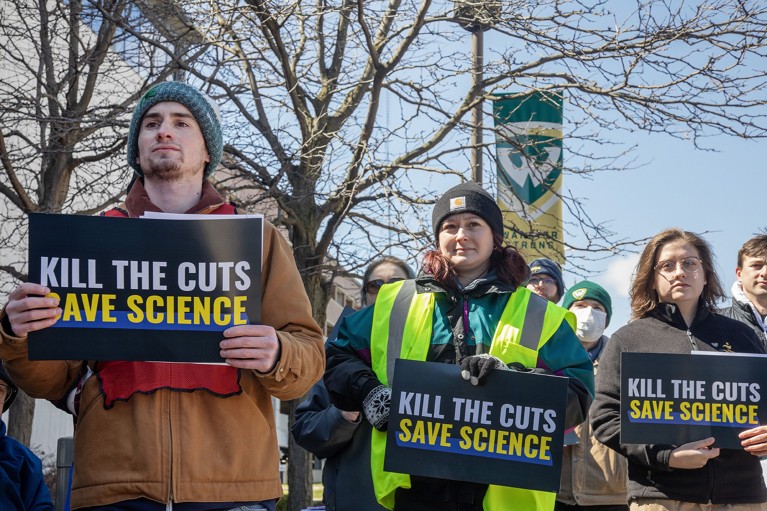
Union members protest towards federal cuts at Wayne State College in Detroit, Michigan, in April 2025.Credit score: Jim West/Getty
The administration of US President Donald Trump is hacking away at funding for analysis establishments — aiming, it says, to eradicate waste and bias in government-funded analysis. That is disrupting science in methods which are rippling effectively past laboratories and lecture halls. Right here, Nature’s Careers crew seems into a few of the figures that may point out wider disruptions to the scientific enterprise.
The variety of energetic grants awarded by federal funding our bodies has fallen strikingly, and corporations that present merchandise to scientists — from primary vials to classy cell analysers — are reporting a downturn in demand from educational and authorities clients. Their considerations are exacerbated by the president’s bulletins of tariffs on international imports, which have triggered retaliatory commerce restrictions in different nations. Some corporations are predicting worth rises fuelled by elevated import prices.
The general public who’ve immediately misplaced grants are principal investigators, however early-career researchers are being affected as effectively, warns Jason Owen-Smith, a sociologist who leads the Institute for Analysis on Innovation and Science (IRIS) consortium on the College of Michigan in Ann Arbor. Drawing on IRIS knowledge, Owen-Smith estimates that nationwide, federal grants to universities assist about 646,000 researchers. About 48% of these are college students and trainees, he says.
Folks exterior academia will even be affected. “An entire lot of companies in a extremely wide selection of industries, from native eating places to building corporations to specialised manufacturing corporations,” Owen-Smith says, “are going to see successful to their backside line because of the cuts.”
Nonetheless, not all areas of scientific exercise have declined within the first quarter of 2025 — some have even picked up. For example, the US Nationwide Bureau of Financial Analysis in Cambridge, Massachusetts, printed extra working papers in January, February and March this yr than in the identical interval of 2024. Globally, publication charges for preprints, journal articles and different analysis content material additionally proceed to extend, according to long-term tendencies. However publication takes time, so this technique of measuring scientific output might be slower to replicate tendencies than will another metrics.
On the finish of the primary quarter, only a few months into the Trump administration, uncertainty about the way forward for US science reigned, as Nature’s charts present. Some statistics are pulled from small subsections of the scientific enterprise, comparable to gross sales from a single provider. Others, together with the variety of federal grants awarded to US scientists, replicate extra elementary shifts.
Total, the image is gloomy, says Andrew Castaldi, a market specialist at Temblor, a risk-assessment firm based mostly in Redwood Metropolis, California. “To me, the federal science funding cuts will make it more durable for any trade to construct off the work executed by the scientists employed by the federal government,” he says. “No single entity has the capability to make up what’s misplaced. In impact, the personal sector’s improvements will diminish.”
Grants withdrawn
US federal science companies have retracted many grants (see ‘Funding’). Greater than 1,000 grants have been terminated between 20 January and the tip of March at three authorities companies: the Nationwide Institutes of Well being (NIH), Nationwide Science Basis (NSF) and NASA. Many extra have been flagged for scrutiny on the grounds that they promote range, fairness and inclusion (DEI), or as a result of analysis in areas together with vaccines and HIV is being de-emphasized. That is destabilizing careers.
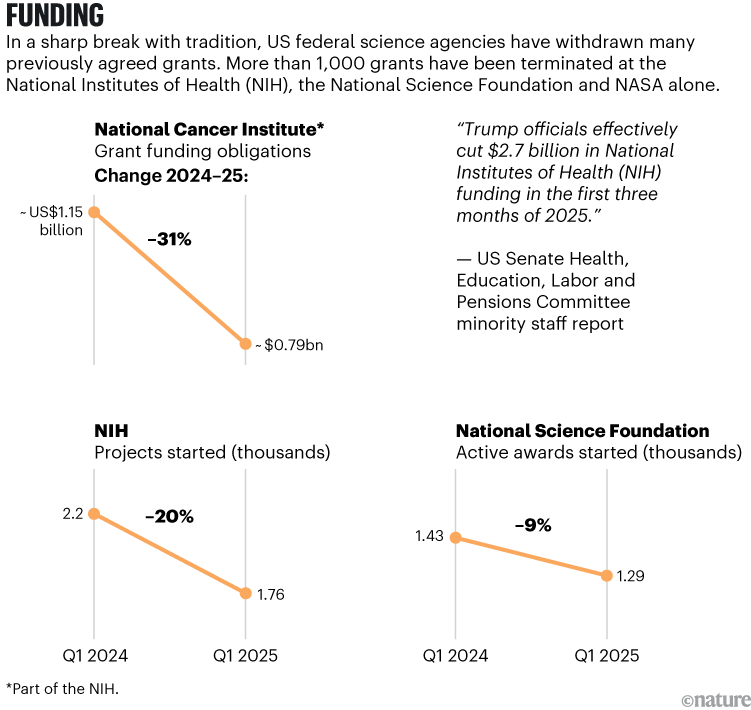
Supply: NIH Reporter; nsf.gov
The scenario is altering quick, nevertheless. Because the finish of March, many extra grants have been cancelled. The US Division of Well being and Human Providers (HHS), of which the NIH is a component, now lists greater than 7,000 terminated contracts. However on 16 June, a US choose dominated that many of those cancellations have been unlawful, and ordered that they be restored. And Harvard College in Cambridge, Massachussetts, is locked in an ongoing authorized battle with the federal authorities after its analysis funding was particularly focused.
Provider and demand
Falling revenues have affected scientific-product suppliers of each dimension (see ‘Lab tools’). For some, a drop in US educational and authorities gross sales is offset by different sectors, so total revenues haven’t declined. However even these corporations are predicting future losses, which could have spooked buyers.
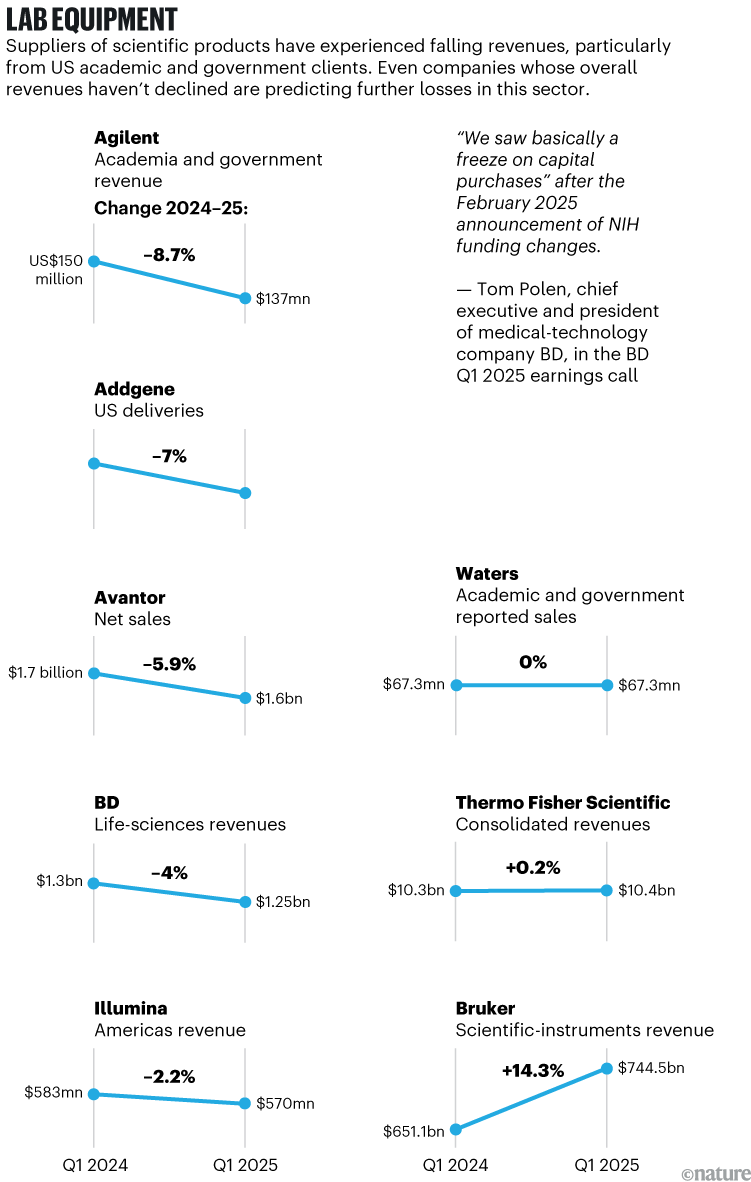
Supply: Agilent; Addgene; Avantor; Waters; BD; Thermo Fisher Scientific; Illumina; Bruker
Let’s get collectively
Some worldwide researchers are reluctant to journey to america amid will increase in border controls. Even US researchers are travelling much less, given cuts in journey budgets at some establishments. And a few convention organizers have needed to postpone or cancel occasions, or relocate them to different nations. Nonetheless, within the first three months of 2025, not all US-based scientific conferences had but been affected (see ‘Conferences’).
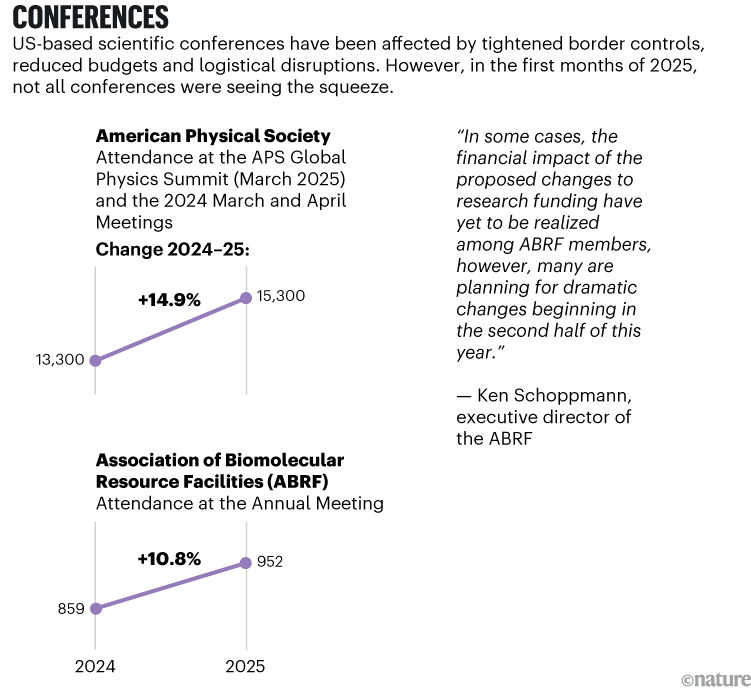
Supply: APS; ABRF
Lease on life sciences
Nationwide, science-related buildings are standing empty (see ‘Property’). That is notably notable in Boston, Massachusetts, the place 25% of the lab or analysis and improvement (R&D) property stock is vacant, in contrast with 14% within the earlier yr, based on the business property agency CBRE in Dallas, Texas.
The Boston–Cambridge space has a excessive focus of universities, life-sciences corporations and associated distributors, and is the most important US marketplace for life-sciences property. Throughout america, demand for such buildings began to fall in the course of the COVID-19 pandemic, however it has intensified in 2025. Corporations are delaying leasing choices owing to uncertainty, though some need to enhance their US operations in response to tariffs on international manufacturing.
The consequences will in all probability cascade into residential housing. Donna Ginther, an economist on the College of Kansas in Lawrence, anticipates a downturn within the property market, saying: “When you have fewer graduate college students, it’s going to have an effect on housing demand.”
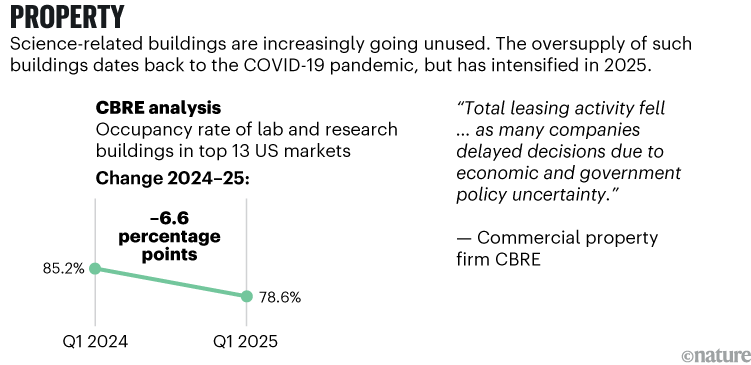
Supply: CBRE Insights report
Job cuts
In relation to employment, the bigger results of funding cuts and tariffs will take time to materialize, Ginther says. 1000’s of workers positions have been reduce from federal science companies together with the NIH, based mostly in Bethesda, Maryland; the Facilities for Illness Management and Prevention, headquartered in Atlanta, Georgia; and the Meals and Drug Administration, based mostly in Silver Spring, Maryland. But total R&D-related employment figures from the Bureau of Labor Statistics barely shifted between the primary three months of 2024 and the primary three months of 2025 (see ‘Employment’).
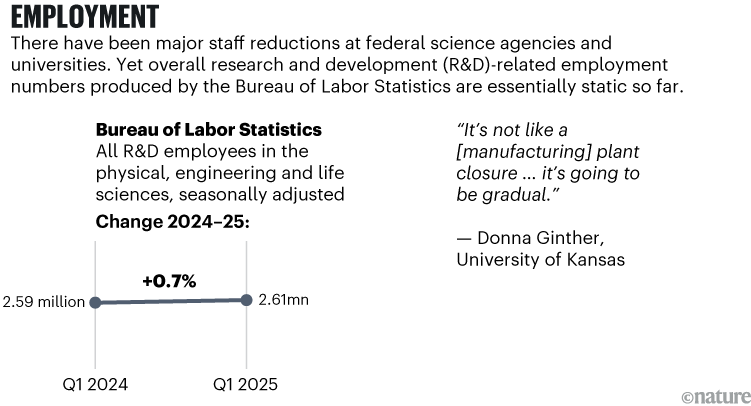
Supply: BLS Employment Statistics survey
Change could be coming. A spokesperson for the Federal Reserve Financial institution of Boston notes: “Payroll employment within the Boston–Cambridge–Newton metro space, which has a tech-heavy economic system, is down 0.3% in March 2025 from one yr earlier.” And a few universities are chopping workers, college students and programmes, whereas others are searching for stopgap options to funding shortfalls.

